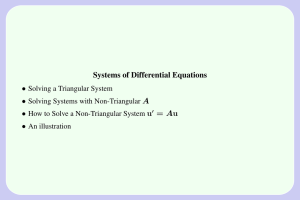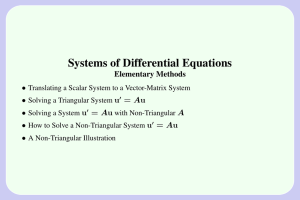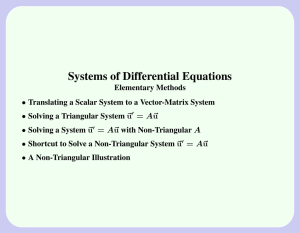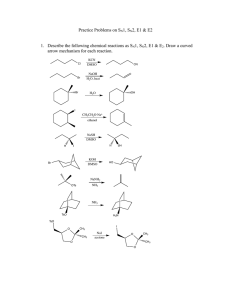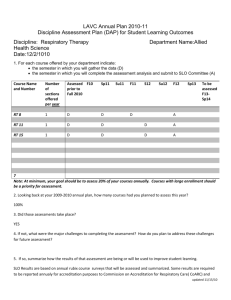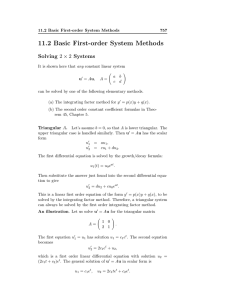Systems of Differential Equations • u = Au
advertisement
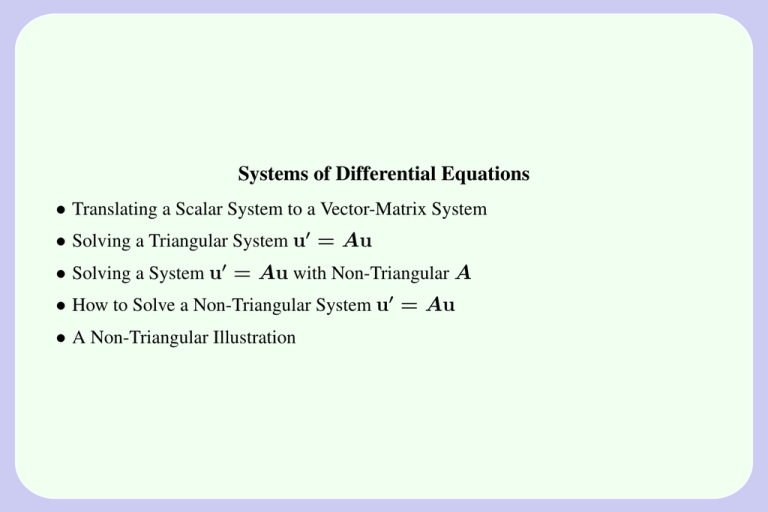
Systems of Differential Equations
• Translating a Scalar System to a Vector-Matrix System
• Solving a Triangular System u0 = Au
• Solving a System u0 = Au with Non-Triangular A
• How to Solve a Non-Triangular System u0 = Au
• A Non-Triangular Illustration
Translating a Scalar System to a Vector-Matrix System
Consider the scalar system
u01(t) = 2u1(t) + 3u2(t),
u02(t) = 4u1(t) + 5u2(t).
Define
u=
u1(t)
u2(t)
,
A=
2 3
4 5
.
Then matrix multiply rules imply that the scalar system is equivalent to the vector-matrix
equation
u0 = Au
Solving a Triangular System
An illustration. Let us solve u0 = Au for a triangular matrix
A=
1 0
2 1
.
The matrix equation u0 = Au represents two differential equations:
u01 = u1,
u02 = 2u1 + u2.
The first equation u01 = u1 has solution u1 = c1 et . The second equation becomes
u02 = 2c1et + u2,
which is a first order linear differential equation with solution u2 = (2c1 t + c2 )et . The
general solution of u0 = Au is
u1 = c 1 e t ,
u2 = 2c1te−t + c2et.
Solving a System u0 = Au with Non-Triangular A
Let A =
a b
c d
be non-triangular. Then both b 6= 0 and c 6= 0 must be satisfied.
The scalar form of the system u0 = Au is
u01 = au1 + bu2,
u02 = cu1 + du2.
Theorem 1 (Solving Non-Triangular u0 = Au)
Solutions u1 , u2 of u0 = Au are linear combinations of the list of atoms obtained
from the roots r of the quadratic equation
det(A − rI) = 0.
Proof of the Non-Triangular Theorem
The method is to differentiate the first equation, then use the equations to eliminate u2 , u02 .
This results in a second order differential equation for u1 . The same differential equation
is satisfied also for u2 . The details:
u001 =
=
=
=
au01 + bu02
au01 + bcu1 + bdu2
au01 + bcu1 + d(u01 − au1)
(a + d)u01 + (bc − ad)u1
Differentiate the first equation.
Use equation u02 = cu1 + du2 .
Use equation u01 = au1 + bu2 .
Second order equation for u1
found
The characteristic equation is r 2 − (a + d)r + (bc − ad) = 0, which is exactly the
expansion of det(A − rI) = 0. The proof is complete.
How to Solve a Non-Triangular System u0 = Au
• Finding u1. The two roots r1, r2 of the quadratic produce an atom list L of two
elements, as in the second order recipe.
In case the roots are distinct, L = {er1 t , er2 t }. Then u1 is a linear combination of
atoms:
u1 = c1er1t + c2er2t.
• Finding u2. Isolate u2 in the first differential equation by division:
u2 =
1
b
(u01 − au1).
The two formulas for u1 , u2 represent the general solution of the system u0 = Au,
when A is 2 × 2.
A Non-Triangular Illustration
Let us solve u0 = Au when A is the non-triangular matrix
A=
1 2
2 1
.
The equation det(A − rI) = 0 is
(1 − r)2 − 4 = 0.
The roots are r = −1 and r = 3. The atom list is L = {e−t , e3t }.
Then u1 is a linear combination of the atoms in L:
u1 = c1 e−t + c2 e3t .
The first equation u01 = u1 + 2u2 implies
u2 =
1
(u01 − u1 )
2
= −c1 e−t + c2 e3t .
The general solution of u0 = Au is then
u1 = c1 e−t + c2 e3t ,
u2 = −c1 e−t + c2 e3t .
